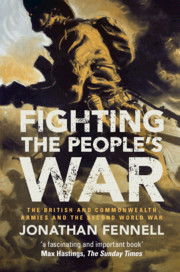Book contents
- Fighting the People’s War
- Armies of the Second World War
- Fighting the People’s War
- Copyright page
- Dedication
- Contents
- Illustrations
- Figures
- Maps
- Tables
- Acknowledgements
- Abbreviations
- Additional material
- Introduction
- Part I The Military and Political Context
- Part II The Great Crisis of Empire
- Part III Transformation
- Part IV The Limits of Attrition
- Part V Redemption
- Part VI The Post-War World
- Conclusion
- Book part
- Notes
- Select Bibliography
- Index
Conclusion
Published online by Cambridge University Press: 21 January 2019
- Fighting the People’s War
- Armies of the Second World War
- Fighting the People’s War
- Copyright page
- Dedication
- Contents
- Illustrations
- Figures
- Maps
- Tables
- Acknowledgements
- Abbreviations
- Additional material
- Introduction
- Part I The Military and Political Context
- Part II The Great Crisis of Empire
- Part III Transformation
- Part IV The Limits of Attrition
- Part V Redemption
- Part VI The Post-War World
- Conclusion
- Book part
- Notes
- Select Bibliography
- Index
Summary
The power of Churchill’s speech still fires the imagination. In this moment of great danger, as Britain faced invasion, the Prime Minister and those around him remained confident that citizens would rise up and sacrifice everything for their country. The strategic calculus governing the Army’s deployment, later in the war, in the Middle East, Europe and the Far East, remained little different; the Empire would rely enormously on the ‘poor bloody infantry’, the ordinary citizen soldier, and his willingness, when called upon, to fight and if necessary die for the cause.
- Type
- Chapter
- Information
- Fighting the People's WarThe British and Commonwealth Armies and the Second World War, pp. 678 - 697Publisher: Cambridge University PressPrint publication year: 2019

